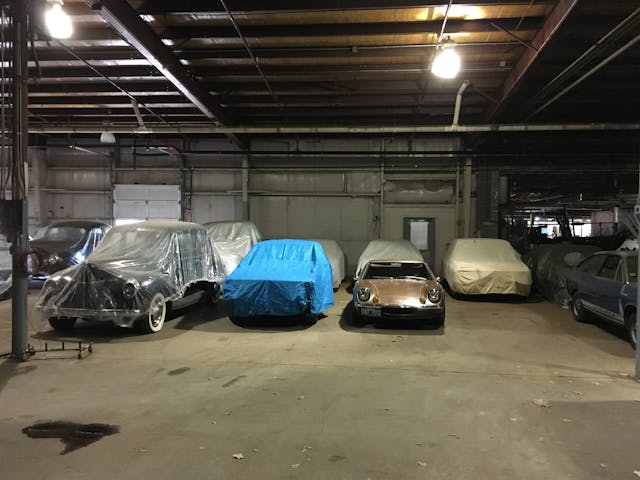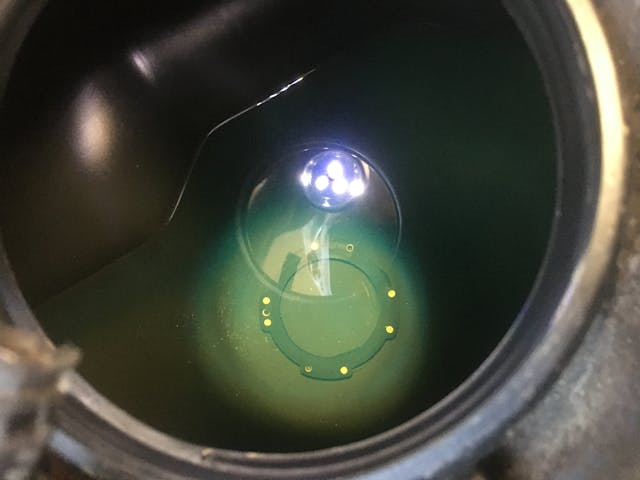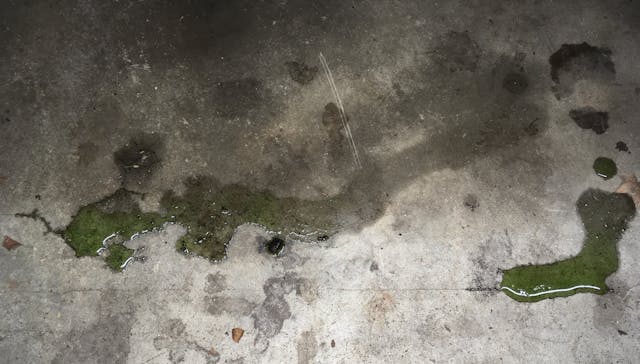Media | Articles
Salt and Snow Can Be Harmful to a Classic, but Your Garage Might Be, Too
Storing an old car during winter is a practice so common that we tend to overlook how damaging it can be. All manner of bad things can and do happen when you take a machine, like a classic car, that’s designed to move and park it. The danger is that three months sometimes turns into six, and trust me, a car’s condition never improves while sitting.
Really, the best situation is where the car is driven every few weeks when the roads are clear, as this keeps things exercised. If you must park your classic, don’t ignore it. Instead, consider the following before, during, and after hibernation.
Space: The tighter and drier, the better. A fabric shelter is better than nothing, but avoid leaving a car sitting over dirt or grass, as they’re sources of humidity that will accelerate rust.

Car Cover: Yes, even in the garage. It keeps particulate matter, the errant falling rake, and stray rodents off the paint. (FYI, HDC members get 10 percent off on California Car Covers.)
Marketplace
Buy and sell classics with confidence

Speaking of Rodents: They can ruin a car by chewing through fabric and wires, nesting under the hood, or leaving, ahem, presents all over your interior. I throw a Bounce dryer sheet on the floor, in the trunk, and under the hood. The theory is that the critters dislike strong smells. Some people use mothballs or peppermint oil. Anything is better than nothing.

Battery: If you have electricity, consider a trickle charger. But be safe about it: Tightly coiled extension cords, fraying wires, and the presence of combustible materials (everything from gasoline tanks to oily rags) can all increase the risk of fire. You might also consider taking the battery out and bringing it to where you can trickle-charge it safely. At minimum, disconnect the negative battery terminal. A healthy battery will probably fire the car right up when connected three months later. Longer than that, you’re pushing it.

Fuel: Ethanol attracts water, and when the fuel can no longer absorb it, the ethanol-water mixture sinks to the bottom. The corrosive mix can rust a metal tank. Ethanol-free gasoline is thus best for storage if you can avoid it, but in many areas, that’s becoming difficult. (Pure-gas.org lists stations that sell ethanol-free gas.) If all that’s available is E10 (10 percent ethanol), by all means fill the tank with it, as the less air there is above the fuel, the less opportunity there is for water absorption. There’s little harm in using short-term fuel stabilizers like Sta-Bil and Star Tron. If the car may sit for years, consider using Sunoco Optima race fuel (beware, it’s pricey).

Tires: Sitting eventually causes tires to flat-spot. I pump mine up to 40 psi prior to storage, but the best prevention is minimizing the time the car sits. If you can occasionally roll it a few feet, do so. There are various pads on the market (Tire Cradles, Flatstoppers) that certainly help. But if the tires are precious and you want to eliminate flat-spotting altogether, buy a set of junk wheels and tires for storage.

Beware the Winter Project: A big repair seems like an ideal use of the winter downtime—and a way to bond with your car even when it’s not moving. It’s a nice theory that, in my experience, has rarely panned out. My garage has heat and a dedicated “project” space, and I’ve done over-winter A/C retrofits and transmission swaps in it, but the heat in the garage is rarely living-room heat, and I can attest to the daily grind getting to be a bit much. Just remember that working on your classic is supposed to be enjoyable. Maybe say yes to stop-when-you-want tinkering, but leave the engine swap for spring.

In the Spring: Generally speaking, the longer the car has been in storage, the more careful you should be. At a minimum, check the fluid levels and look under the car for puddles. I’ll often pull the air cleaner housing off just to be certain that a mouse nest isn’t about to get sucked into the engine. Carbureted cars with mechanical fuel pumps typically need help starting. I’ve never seen the harm of a blast or two of starting fluid to get the car running and fuel drawn into the float bowls. My routine is to let the car idle for a minute, shut it off and check for leaks, inflate the tires to spec, then drive it around the block and check again for leaks.
***
This story first appeared in the January/February 2025 issue of Hagerty Drivers Club magazine. Join the club to receive our award-winning magazine and enjoy insider access to automotive events, discounts, roadside assistance, and more.
Rob’s latest book, The Best Of The Hack Mechanic™: 35 years of hacks, kluges, and assorted automotive mayhem, is available on Amazon here. His other seven books are available here on Amazon, or you can order personally inscribed copies from Rob’s website, www.robsiegel.com.











I visited a friend who had many cars in storage and he had no heat, but fans running constantly. His theory was that stagnant air promotes condensation and mold. I’m not sure if it’s scientifically sound, but I run the ceiling fan in my garage on low all winter. I have a gas heater on the wall, so it also helps to circulate the warm air and manage that humidity that the heater generates.
If the roads are dry I drive my vettes all year. I try for 50 to 100 miles a week on average all year. Cold never harmed a car.
It is not mainly the cold, but rather, the road salt that is damaging.
Cold is NOT great for fiberglass cars. It contributes greatly to cracking.
I seal my car inside a car bag. But prior to pulling the final few inches of the car bag zipper, the car is thoroughly cleaned inside and out, the gas tank is filled to the neck, 11 car desiccant bags (about the size of corn hole bags) are placed under the car, plus one or two more inside the car, the windows are cracked slightly, a battery tender is connected, a high quality car cover is used, and then on top of the car cover, several very soft blankets are methodically placed on top and around of the car. Once the car is sealed, the garage is maintained at roughly 50 degrees with relatively low humidity where it sits for roughly 6-7 months.
Am I suppose to believe I’m the only OCD one here that puts the car on jack stands for the winter? No flats, no dry rot.
Jack stands can also take stress off the springs if placed properly. My 1984 Mercedes 500SL euro survived two feet of salt water from Hurricane Helene this fall on jack stands ( just rinsed out the floor pan and charged up the battery) while my electronics-loaded (at floor pan level) 2001 Mercedes E320 wagon and 2009 ML350 were both toast.
Wow, very lucky on the SL, but condolences on the other two, Roy. Out here in the arid west, it’s just hard to conceive of such a thing, but my sympathy goes out to people who were hit so hard by Helene.
Of course, out here in the arid west (or at least parts of it), we have to concern ourselves more with wildfires than flooding.
Agree with traps over poison which kills not only cats but the owls and hawks. These predators clearly help control the rodent population so poison is doubly bad.
Can recommend Ketch-All Mousetrap. No bait, multiple captures without resetting and sometimes (not always) humane. Beats the snap traps hands down. I use them indoors and outdoor with great result. Relatively expensive but what’s a wiring harness cost?
I have had good luck with mouse control with a product called “Fresh Cab”, which is packets of balsam oil-infused material. Baited spring traps around the cars also helps control mice. I use both, and have very few (but not NO) problems with mice anymore; I used to have major infestations. Inspection every couple of weeks for telltale signs of mice in the car is also a good idea.
Not a classic but I park my 2014 Chevy Cruze for the winter and drive my 4×4 Cruze not the greatest in the deep snow we get around me. One year after the car was sitting for a few months it developed an anti freeze leak. There is a metal tube that connects to the thermostat housing and I believe the water pump with an O-ring on either end. One of the O -rings leaked. Kicker is I went to the dealer and Chevy decided to put 2 different thermostat housings on my engine. So I had to go back home and get the VIN number. Also I think it was about $7 for the O-ring. Replaced both while it was apart
The dealer wanted to confirm they were selling you the correct part and you complain? That sounds like good service if I’m being honest. I’m all for hating dealers, but this story ain’t it.
Guess you missed that the dealer couldn’t even figure out which one was correct the first time.
What’s a “VIN number”? Or is there an echo in here here?
Nah, why? why?
We’re trying a new trick Mrs. Tinkerah read about: a couple shallow trays of used but scooped cat litter in and around the car. Allegedly the scent of a predator will keep rodents away. I’m skeptical since our indoor mouser is able to lure them close enough for capture (arrest?). The jury is deliberating until spring.
Bill P: once your car is bagged with desiccant there’s no need to heat or dehumidify the rest of the space.
Used cat litter IN the car? Eeewwww….
I had to read that twice to be sure….
Don’t wrap it too tightly. Years ago, I covered a boat (outdoors on a boat lift) with a tarp (treated cotton canvass, not poly). When I uncovered it in the spring, the engine was dripping with condensation. In subsequent years, I always left an opening at the bow and another at the stern for flow-through ventilation.
Just to follow up on the car cover question; during winter long term storage I keep my windows down a coupe of inches. But during the warm active driving months when my cars often live in the driveway with a thicker car cover, I always leave the windows all the way down-especially during/after a rain storm. It makes a huge difference with internal humidity as well as heat. Just make sure the cover can’t blow off in the rain and that curious cats can’t get in. Frankly, I’m more worried about cat claws than mice.
I have a bunch- if your concrete floor isn’t epoxy sealed, park the car on plastic and preferable in a bag. Over a long winter pull the battery out and have on a tender. Seal the hell out of the garage and have mouse traps with bait all over the place, including a couple on a piece of cardboard on the front mats and check them every few days. Dehumidifier in damp climates and dehydrating calcium chloride inside them. Put up on jack stands or blocks of wood. Never had a problem with anything.
I started using a Car Capsule probably 25 years ago. They have a small fan with a filter, so zero moisture, dust, or critters. I upgraded to a Car Capsule Showcase 10 years ago. It stays inflated even when you want to go inside and attend to the car, as it has sealed air support columns. It is right next to the bay that I wash cars in, and no stray droplets touch my car. Provides great protection from things coming in contact with whats inside too. They are not cheap, well worth it to me!
Large(ish) winter projects. Some years ago I took on rebuilding the front suspension on my 2002 as a winter project. In Ohio, in an unheated garage. Not wise decision, as many stuck/rusted bolts, having to figure out and make bushing pullers/installers, and the inevitable mission creep (might as well clean/paint the parts while I’m at it) turned it into an on/off two month project. Fortunately I had a little ceramic heater that fit nicely into the wheel well where I was working. A little bench in front of the heater kept the tools warm(ish) and some thick foam rubber insulated my posterior from that cold garage floor. My incentive to finish was an early spring out-of-state car show that I really wanted to attend. I made it.
And in the “doesn’t he learn a lesson?” category, the following winter I did the same job, in the same cold, with the same frustrations, to my other 2002.
No mice problems here.
I raised the hood on a car i never drive, noticed a small nest of white fur, on area near the transmission.
Turns out our kitty (a fuzzy ragdoll) had been crawling up from under the car and sleeping there.
I guess she felt safe in there.
We get coyote patrols at night and other Tom’s looking for a territory dispute. Probably an occasional mouse for her to snack on…
I’ve heard that you should park the car on a plastic tarp, even on a concrete floor because the moisture in the concrete is always being released.